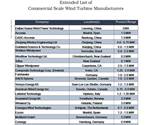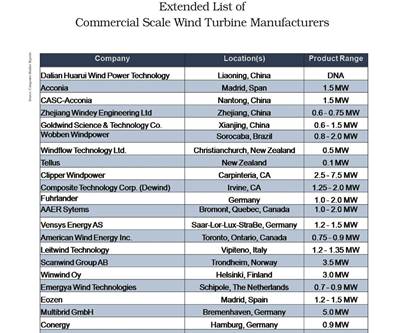Alternative energy growth creating secular demand for composites
Alternative energy sources, such as solar, wind, and geothermal, are finally emerging as contenders alongside our primary electric-power-producing fossil fuels, natural gas and coal (but not oil), primarily because these technologies are ready for widespread distribution and adoption, based on average pricing for electricity.
The 2006 World Energy Outlook report by the International Energy Assn.
(IEA) stated that solar, wind, ocean and geothermal power technologies
will account for just over 9 percent of global power generation by
2030. That does not sound like much of an energy revolution — until you
consider that 9 percent of total global power generation in 2030 will
be on the order of 1 billion megawatt hours. A second, more recent
United Nations Environmental Programme (UNEP) study entitled Global
Environment Outlook: Environment for Development (GEO-4) predicted even
higher percentages for alternative energy, perhaps as much as 23
percent, by 2030. A third report from IEA concerning carbon emissions
has estimated that a global investment of $45 trillion (USD) in
alternatives will be needed by 2050 to attain the 50 percent reduction
in carbon emissions suggested by the Intergovernmental Panel on Climate
Change. Alternative energy is now a viable, sustainable industry with
interesting financial implications for advanced composites.
Alternative energy sources, such as solar, wind, and geothermal, are
finally emerging as contenders alongside our primary
electric-power-producing fossil fuels, natural gas and coal (but not
oil), primarily because these technologies are ready for widespread
distribution and adoption, based on average pricing for electricity. To
help these alternatives compete in the growing energy marketplace,
governments in some areas of the world, at least, are offering
significant incentives that make investments in alternative energy
attractive. Germany and Japan, for example, have funded developmental
programs in solar energy that have been largely successful. China,
simply based on need, is bankrolling various government investments in
alternative energy, as are Italy and Spain. In the U.S., the growth of
alternative energy sources, particularly wind power, is strong thanks
to individual state renewable portfolio standards. Yet the federal
government continues to drag its feet on long-term extensions of the
solar investment tax credit (ITC) and the wind/geothermal production
tax credit (PTC) — both of which are set to expire in December of this
year.
So where do advanced composites fit into this burgeoning
market? Composite materials are important components in several of the
alternative energy subsectors, primarily wind power and compressed
natural gas, and soon will assume a greater role in automotive and
transportation applications.
Wind power growth continued in 2007
with 20 gigawatts (GW) of new installations in 2007, according to the
Global Wind Energy Coun-cil (Brussels, Belgium), with the U.S. leading
the way at an estimated 5.2 GW installed. The price to produce
electricity from wind is a bit higher (5.5 to 7.5 cents per kilowatt
hour) than fossil fuel “grid pricing,” which is estimated at 2 to 4
cents per kilowatt hour for coal. (Consumers in the U.S. pay, on
average, about $0.15/kWh.) That is why the soon-to-expire PTC — a
2-cent incentive (30 percent of a producer’s average cost) — is so very
important to sustained growth in the U.S. As the public’s desire for
clean energy is coupled with the need for energy independence, the
financial viability of wind projects is an important factor for further
deployment, and composite materials offer a compelling solution for
increasing energy efficiency and reducing the cost of energy as well.
Wind power is a well-understood, mature technology, and increasing the
scale of turbines up to perhaps 5 MW is one of the best methods to
increase efficiency, reduce costs, and achieve that as yet elusive
point of “grid parity,” whereby the costs of produced electricity from
wind power and from fossil fuels are equal.
OEMs are able to
increase turbine size and capacity because the use of advanced
composites makes it practical to build the much longer rotor blades
they require. Using a combination of fiberglass and carbon fiber,
blades built to lengths of up to 50m/164 ft are lighter and stronger
than all-glass blades, thus increasing turbine efficiency and reducing
the cost to implement wind power.
Natural gas is a cleaner
alternative to coal and oil, but a lingering issue for natural gas is
that much of the known reserves are “stranded” or located far from
existing infrastructure and pipelines. At least one major new
application, still under development, would transport natural gas to
market in large composite storage cylinders on purpose-built ships.
Carbon fiber demand driven by this application could approach 2,000
metric tonnes (more than 4.4 million lb) in 2008. Another major
application that could spur demand for natural gas storage cylinders is
natural gas-powered transportation vehicles, which have begun to gain
some market acceptance.
A third application for composites in
relation to alternative energy is the introduction of carbon fiber into
automotive vehicle parts for any type of vehicle, whether conventional,
electric or hybrid. Lightweight composites could reduce weight by as
much as 30 percent when compared to steel, thus increasing fuel mileage
without commensurate reductions in safety. But, as many of you well
know, material pricing, fabrication and tooling remain large
impediments to achieving a mass-production scale.
Additional
applications for composites still in the research and development stage
include hydrogen fuel storage vessels, fuel cell components, electrical
transmission lines, flywheel technology, tubing and piping for
geothermal directional drilling, solar panel support structures and
wave/ocean power components. Many of these R&D projects might never
see commercial adoption, yet the focus on and investment in alternative
energy will continue to propel novel applications for composites.
The 625 percent increase in investment in alternative energy
technologies from the 2001 estimate of $714 million to $5.2 billion in
2007 signals long-term, secular growth in the industry. I estimate that
the annual use of carbon fiber related to alternative energy
applications could approach 18,150 metric tonnes (40 million lb) by
2010, producing nearly $650 million in revenue. In the same time frame,
annual figures for fiberglass could reach almost 226,800 metric tonnes (500 million lb), with
revenue of $1.5 billion in revenue for fiberglass, by 2010.
Without question, the continued penetration of composites technology
into the alternative energy industry is stimulating rapid — and
increasingly stable and sustainable — growth in the demand for
materials and manufactured components from the advanced composites
industry.
Brian Yerger covers
the alternative energy industry for Jesup & Lamont and publishes
from the Mid Atlantic regional office in Wilmington, Del. He joined the
company’s research department in 2007, after 15 years on Wall Street in
sales, trading and investment banking. Yerger holds a BS in business
administration from the University of Delaware. Frequently quoted in
Barron’s, Bloomberg, BusinessWeek, Forbes and the Wall Street Journal. A presenting expert at forums presented by CFA Society of
Philadelphia and COMPOSITESWORLD Conferences, he is a Chartered
Financial Analyst (CFA)™ charterholder and a member of the CFA Society
of Philadelphia, holding the following series registrations: 7, 63, 65,
86 and 87.
Related Content
Hexagon Purus opens new U.S. facility to manufacture composite hydrogen tanks
CW attends the opening of Westminster, Maryland, site and shares the company’s history, vision and leading role in H2 storage systems.
Read MoreDrag-based wind turbine design for higher energy capture
Claiming significantly higher power generation capacity than traditional blades, Xenecore aims to scale up its current monocoque, fan-shaped wind blades, made via compression molded carbon fiber/epoxy with I-beam ribs and microsphere structural foam.
Read MoreInfinite Composites: Type V tanks for space, hydrogen, automotive and more
After a decade of proving its linerless, weight-saving composite tanks with NASA and more than 30 aerospace companies, this CryoSphere pioneer is scaling for growth in commercial space and sustainable transportation on Earth.
Read MoreUpdate: THOR project for industrialized, recyclable thermoplastic composite tanks for hydrogen storage
A look into the tape/liner materials, LATW/recycling processes, design software and new equipment toward commercialization of Type 4.5 tanks.
Read MoreRead Next
Wind turbine blades: Big and getting bigger
Two decades of technical and market development has made this once marginal application a global giant and one of the world’s largest markets for composites.
Read MorePlant tour: Daher Shap’in TechCenter and composites production plant, Saint-Aignan-de-Grandlieu, France
Co-located R&D and production advance OOA thermosets, thermoplastics, welding, recycling and digital technologies for faster processing and certification of lighter, more sustainable composites.
Read MoreAll-recycled, needle-punched nonwoven CFRP slashes carbon footprint of Formula 2 seat
Dallara and Tenowo collaborate to produce a race-ready Formula 2 seat using recycled carbon fiber, reducing CO2 emissions by 97.5% compared to virgin materials.
Read More






.jpg;maxWidth=300;quality=90)














